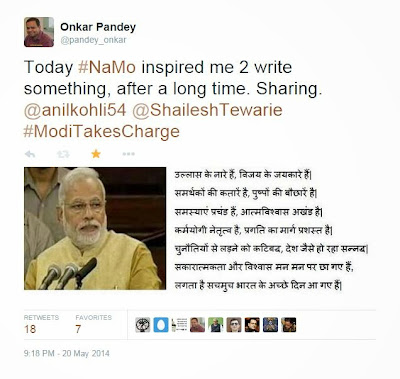Background:
Expectations:
Report Card:
I will try to do justice with these initiatives by covering them in separate dedicated posts coming soon.
Tweet
When India prepared to go through the 16th General Elections after her independence, it was different than any other general elections held in the past. There was a feeling of restlessness amongst people. Stories of rampant corruption and new scams was an everyday affair. Indian youth was in the depth of despair and it seemed there was no option and no way to stop the rot and bring this great nation to its old glory.
 |
| Courtesy: @manjultoons |
This is when the main opposition party, BJP, announced the then Chief Minister of Gujarat, Narendra Modi, as its Prime Ministerial candidate. Modi had won the third consecutive election in Gujarat in December, 2012 and was seen as a development oriented politician by the young electorate. The Congress party was planning to field Rahul Gandhi as its prime ministerial candidate, but, the announcement of BJP to field Narendra Modi as PM candidate baffled Congress. The gaffes of Rahul Gandhi were no match to splendid track record of Narendra Modi as Chief Minister of Gujarat. With every passing day, the battle started intensifying.
In the meanwhile, the anti corruption movement that came into effect during the UPA-2 tenure, was converted into a political party named as "Aam Aadmi Party". This party, that was apparently formed to fight corruption, started to show the greed for power after winning Delhi Assembly election in December, 2013. Ambitions of the AAP leaders started to float in air and they started visualising themselves as a third alternative after BJP and Congress at the national level. With "traditional" third front in completed disarray, Indian Media that is invariably looking for dramatic and sensationalized news items, provided them all the coverage they needed to advertise themselves as the third but "most honest" option. With unexpected media support and their heads in the cloud, the Aam Aadmi Party decided to contest the Lok Sabha elections at national level. Majority of news channels that did not like Narendra Modi due to their own prejudices and hidden agendas were quick to declare the AAP as the dark horse who according to them was ready to upset BJP and Narendra Modi's apple cart. The so called poll experts started calling it a three way fight between Congress, BJP and AAP.
Poll Results:
The voter turnout was the biggest in the history of Indian General Elections with 66.4% of electorate casting their votes to choose their next government. There were myriad number of opinion polls and exit polls on various news channels. Some predicted a hung parliament and some predicted absolute majority for NDA with a slender margin. But when the final results were declared, majority of "political pundits" were completely taken aback by the outcome of election. BJP had won an absolute majority on its own and NDA as a coalition fell a little short of the two third majority mark in Lok Sabha. The People of India had chosen promise of development and good governance over the reigning corruption. Aam Aadmi Party turned out to be a damp squib losing deposit on 96% of seats the party contested.
 |
| Strength of Parties in Lok Sabha |
Expectations:
This victory was the first one since 1984 when a single party got the absolute majority in Lok Sabha. In 1984, the stunning majority that Congress party got was influenced by the sympathy wave created by assassination of Mrs Indira Gandhi. On the other hand, the victory of BJP under the leadership of Narendra Modi was indicating presence of a different wave. The wave aimed at changing the 'status quo' in Indian politics. This wave was created by Indian youth that rallied behind Narendra Modi to hand over an unprecedented win to BJP. They had many expectations from the leadership of Narendra Modi.
I expressed my feelings and expectations in the form of a small poetry.
Report Card:
NDA government took oath of office on 26-May-2014 with Narendra Modi sworn in as the 15th Prime Minister of India. A cabinet of ministers took oath in the same ceremony. In his first cabinet meeting chaired by the Prime Minister, the first decision that the cabinet took was to form a Special Investigation Team (SIT), headed by a retired Supreme Court Judge, to probe black money stashed abroad.
 |
| Oath of Office |
With this decision, the government got cracking to get the economy back on track through various initiatives and schemes. The rot of last 10 years of Congress rule was big and systemic changes were needed to clean it up. However, it looks like the government has got its feet in the door.
The government initiated various programs and schemes that cannot be described in one blog post.
These initiatives include:
- Strategic Alignment of (neutral) Neighbours with India
- Swachh Bharat and Namami Gange Mission
- Make In India
- Formation of NITI Aayog
- Focus on Policy and Processes
- Financial Inclusion of poor through Jan Dhan Yojana
- Social Security for everybody through Atal Pension Yojana and PM Bima Yojana
- Passing the Black Money bill
- Coal Block and 2G Spectrum Auction
- Money Lending for un-organized sector through Mudra Bank
- Land Acquisition Bill
- Goods and Services Tax Bill
- Recognition of India by various World Forums
I will try to do justice with these initiatives by covering them in separate dedicated posts coming soon.
Tweet

